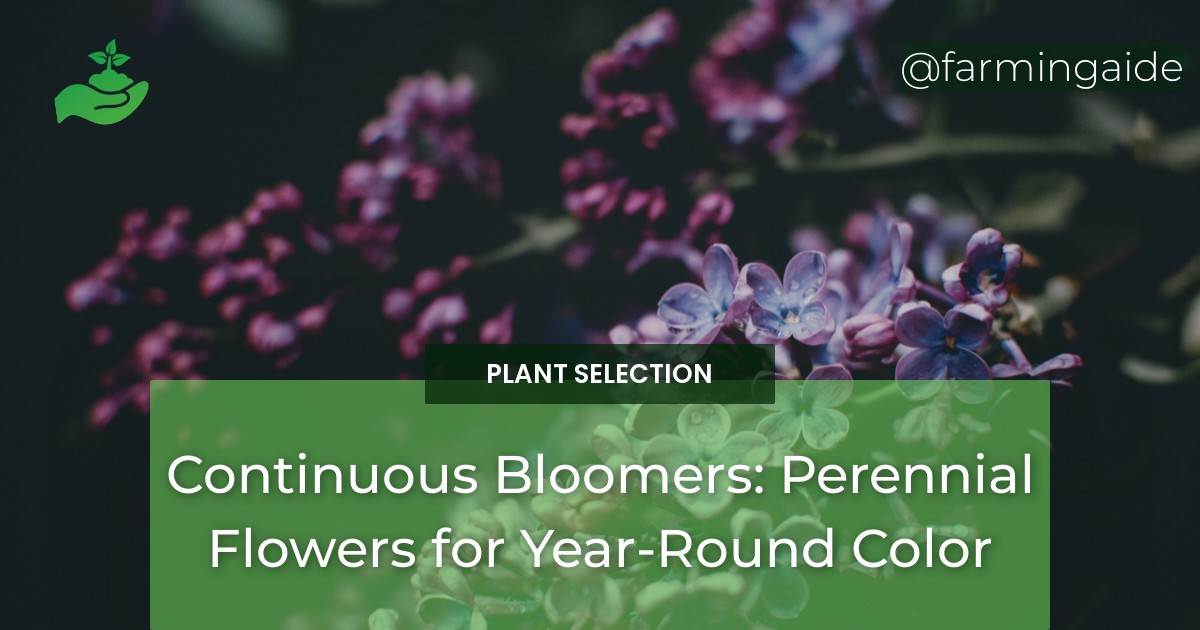Continuous blooming perennial flowers are an excellent choice for any garden design. These flowers bloom throughout the year, providing a beautiful array of vibrant colors. Perennial flowers are plants that come back year after year, making them a cost-effective and sustainable choice for any garden. In this article, we will discuss the different types of perennial flowers for year-round color, factors to consider when choosing them, and tips for maintaining continuous blooms.
Types of Perennial Flowers for Year-Round Color
Spring-Blooming Perennials
Spring-blooming perennial flowers are a great way to add vibrant color to your garden after a long winter. Some recommended varieties include:
- Tulips
- Daffodils
- Crocuses
- Hyacinths
It is important to plant these bulbs in the fall to ensure they bloom in the spring. Make sure to plant them in well-drained soil and in areas with plenty of sunlight. Deadhead faded flowers to encourage continuous blooming.
Summer-Blooming Perennials
Summer-blooming perennial flowers are a great way to add color to your garden during the warmer months. Some recommended varieties include:
- Black-eyed Susans
- Daylilies
- Coneflowers
- Phlox
It is important to plant these flowers in well-drained soil and in areas with full sun to encourage continuous blooming. Deadhead faded flowers and feed the plants every four to six weeks to encourage growth and blooms.
Fall-Blooming Perennials
Fall-blooming perennial flowers are perfect for adding color to your garden as summer fades away. Some recommended varieties include:
- Mums
- Asters
- Heleniums
- Sedums
It is important to plant these flowers in late spring or early summer to ensure they bloom in the fall. Plant them in areas with full sun and well-drained soil. Deadhead faded flowers and feed the plants every four to six weeks to encourage growth and blooms.
Winter-Blooming Perennials
Winter-blooming perennial flowers are perfect for adding color to your garden during the colder months. Some recommended varieties include:
- Winter jasmine
- Hellebores
- Cyclamen
- Pansies
Plant these flowers in late summer or early fall in areas with full sun or partial shade. Provide well-drained soil and water when the soil is dry. Deadhead faded flowers and feed the plants every four to six weeks to encourage growth and blooms.
Factors to Consider When Choosing Perennial Flowers
Sunlight Requirements
When choosing perennial flowers for your garden, it is important to consider their sunlight requirements. Some recommended varieties for different sunlight conditions include:
- Full sun: Coneflowers, Black-eyed Susans, Daylilies
- Partial shade: Hostas, Astilbes, Bleeding Hearts
- Full shade: Ferns, Hellebores, Lenten Roses
Plant these flowers in areas with the appropriate amount of sunlight to encourage continuous blooming. Make sure to water them regularly and deadhead faded flowers to encourage new growth.
Soil Type and pH
Soil type and pH can greatly affect the growth of perennial flowers. Some recommended varieties for different soil types and pH levels include:
- Clay soil: Coneflowers, Black-eyed Susans, Daylilies
- Sandy soil: Lavender, Sedums, Yarrow
- Acidic soil: Rhododendrons, Azaleas, Hydrangeas
- Alkaline soil: Delphiniums, Columbines, Larkspur
Plant these flowers in soil with the appropriate pH level and water them regularly. Deadhead faded flowers and feed the plants every four to six weeks to encourage growth and blooms.
ALSO READ
Tips for Maintaining Continuous Blooms
Deadheading
Deadheading is the process of removing faded flowers from plants. This encourages new growth and blooms, making it an essential technique for maintaining continuous blooms. Techniques for deadheading different types of perennial flowers include:
- Pinching off spent blooms with your fingers
- Using shears to cut off spent flowers
- Cutting back the entire plant to a certain point
Fertilization
Fertilization is an important part of maintaining healthy and blooming perennial flowers. Recommended fertilizers for perennial flowers include:
- Organic fertilizers
- Slow-release fertilizers
- Compost
Follow the instructions on the fertilizer package for best results. Fertilize every four to six weeks during the growing season for continuous blooms.
Watering
Proper watering is essential for maintaining healthy and blooming perennial flowers. Recommended watering techniques for perennial flowers include:
- Watering deeply and infrequently
- Avoiding overhead watering
- Watering in the morning or evening
Water the plants when the soil is dry and make sure to water the roots, not the leaves. Overwatering can lead to root rot and other problems.
Conclusion
Continuous blooming perennial flowers are an excellent choice for any garden design. They provide vibrant color throughout the year and are easy to maintain with the right techniques. When choosing perennial flowers, consider their sunlight requirements and soil type and pH. Maintain continuous blooms by deadheading, fertilizing, and watering the plants properly. With these tips in mind, your garden will be full of beautiful colors all year round.
RELATED ARTICLES:


